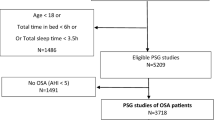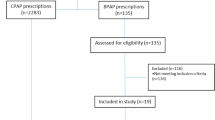Abstract
Background
Sleep bruxism (SB) is often found to co-exist with obstructive sleep apnea (OSA). However, there are no data on prevalence and risk factors of SB in patients with OSA patients regarding the effect of optimal positive airway pressure (PAP).
Objective
This study aimed to study prevalence and risk factors of SB in OSA and to compare SB episodes during pre-treatment versus during optimal PAP therapy.
Methods
This investigation was a retrospective study including randomly selected patients with OSA who underwent split-night polysomnography. Data were collected from August 2021 to October 2022. Clinical demographic data and SB data were analyzed. The association between SB episodes and obstructive respiratory events were manually reviewed. If most of the SB episodes were observed within 5 s following obstructive respiratory events, SB was defined as SB associated with OSA. Comparison of SB index (SBI) was made between baseline portion of the study versus during optimal PAP.
Results
Among 100 patients enrolled, mean age was 50.8 ± 16.7 years and 73 subject (73%) were male. Mean respiratory disturbance index (RDI) and mean nadir oxygen saturation were 52.4 ± 33.4 and 79.3 ± 11.2% respectively. During the baseline portion of the study, 49 patients (49%) had SB and 31 patients (31%) had severe SB (SBI ≥ 4). Sleep bruxism associated with OSA was observed in 73.5% of all SB. The risk factor for SB was endorsement of nocturnal tooth grinding (odds ratio (OR) 5.69, 95%CI 1.74–18.58). Risk factors for severe bruxism were male sex (OR 4.01, 95%CI 1.02–15.88) and endorsement of nocturnal tooth grinding (OR 9.63, 95%CI 2.54–36.42). Risk factors for SB associated with OSA were non-supine RDI (OR 1.02, 95%CI 1.001–1.034) and endorsement of nocturnal tooth grinding (OR 5.4, 95%CI 1.22–23.93). In SB group, when comparison was made between baseline portion and during optimal PAP, significant reduction of SBI was observed (5.5 (3.2, 9.3) vs. 0 (0, 2.1), p < 0.001). Median difference of SBI between baseline portion and during optimal PAP was 4.4 (2.0, 8.3) (p < 0.001).
Conclusions
In this group of patients with OSA, almost half was observed to have SB in which the majority were associated with OSA. Optimal PAP resulted in a significant reduction in SB episodes. In addition to endorsement of nocturnal tooth grinding, non-supine RDI was observed to be a potential risk factor for SB associated with OSA.


Similar content being viewed by others
Data availability
Our manuscript has no associated data.
References
Tan M, Yap AU, Chua AP, Wong J, Parot M, Tan K (2019) Prevalence of sleep bruxism and its association with obstructive sleep apnea in adult patients: a retrospective polysomnographic investigation. J Oral Facial Pain Headache 33(3):269–277. https://doi.org/10.11607/ofph.2068
Lobbezoo F, Ahlberg J, Glaros AG et al (2013) Bruxism defined and graded: an international consensus. J Oral Rehabil 40:2–4. https://doi.org/10.1111/joor.12011
Mayer P, Heinzer R, Lavigne G (2016) Sleep bruxism in respiratory medicine practice. Chest 149:262–271. https://doi.org/10.1378/chest.15-0822
Carra MC, Huynh N, Lavigne G (2012) Sleep bruxism: A comprehensive overview for the dental clinician interested in sleep medicine. Dent Clin N Am 56:387–413. https://doi.org/10.1016/j.cden.2012.01.003
Lavigne G, Manzini C, Huynh NT (2011) Sleep bruxism. In: Kryger MH, Roth T, Dement WC (eds) Principles and practice of sleep medicine. Elsevier Saunders, St Louis, pp 1128–1139
American Academy of Sleep Medicine (2014) International classification of sleep disorders, 3rd edn. American Academy of Sleep Medicine, Darien
Berry RB, Quan SF, Abreu AR et al (2020) The AASM Manual for the Scoring of Sleep and Associated Events: Rules, Terminology and Technical Specifications, Version 2.6. American Academy of Sleep Medicine, Darien
Hosoya H, Kitaura H, Hashimoto T et al (2014) Relationship between sleep bruxism and sleep respiratory events in patients with obstructive sleep apnea syndrome. Sleep Breath 18:837–844. https://doi.org/10.1007/s11325-014-0953-5
Saito M, Yamaguchi T, Mikami S et al (2013) Temporal association between sleep apnea hypopnea and sleep bruxism events. J Sleep Res 23:196–203. https://doi.org/10.1111/jsr.12099
Ohayon MM, Li KK, Guilleminault C (2001) Risk factors for sleep bruxism in the general population. Chest 119:53–61. https://doi.org/10.1378/chest.119.1.53
Manfredini D, Ahlberg J, Winocur E, Lobbezoo F (2015) Management of sleep bruxism in adults: a qualitative systematic literature review. J Oral Rehabil 42(11):862–874. https://doi.org/10.1111/joor.12322
Macedo CR, Macedo EC, Torloni MR, Silva AB, Prado GF (2014) Pharmacotherapy for sleep bruxism. Cochrane Database Syst Rev (10):CD005578. https://doi.org/10.1002/14651858.CD005578.pub2
Shim YJ, Lee MK, Kato T, Park HU, Heo K, Kim ST (2014) Effects of botulinum toxin on jaw motor events during sleep in sleep bruxism patients: a polysomnographic evaluation. J Clin Sleep Med 10(3):291–298. https://doi.org/10.5664/jcsm.3532
Senaratna CV, Perret JL, Lodge CJ et al (2017) Prevalence of obstructive sleep apnea in the general population: a systematic review. Sleep Med Rev 34:70–81. https://doi.org/10.1016/j.smrv.2016.07.002
Peppard PE, Young T, Palta M, Skatrud J (2000) Prospective study of the association between sleep-disordered breathing and hypertension. N Engl J Med 342:1378–1384. https://doi.org/10.1056/NEJM200005113421901
Javaheri S, Barbe F, Campos-Rodriguez F et al (2017) Sleep apnea: Types, mechanisms, and clinical cardiovascular consequences. J Am Coll Cardiol 69:841–858. https://doi.org/10.1016/j.jacc.2016.11.069
Patil SP, Ayappa IA, Caples SM, Kimoff RJ, Patel SR, Harrod CG (2019) Treatment of adult obstructive sleep apnea with positive airway pressure: an American Academy of Sleep Medicine Clinical Practice Guideline. J Clin Sleep Med 15(2):335–343. https://doi.org/10.5664/jcsm.7640
Pauletto P, Polmann H, Conti Réus J et al (2022) Sleep bruxism and obstructive sleep apnea: association, causality or spurious finding? A scoping review. Sleep 45(7):073. https://doi.org/10.1093/sleep/zsac073
Martinot JB, Borel JC, Le-Dong NN et al (2020) Bruxism relieved under CPAP treatment in a patient with OSA syndrome. Chest 157(3):e59–e62. https://doi.org/10.1016/j.chest.2019.07.032
Dumais IE, Lavigne GJ, Carra MC, Rompré PH, Huynh NT (2015) Could transient hypoxia be associated with rhythmic masticatory muscle activity in sleep bruxism in the absence of sleep-disordered breathing? A preliminary report. J Oral Rehabil 42(11):810–818. https://doi.org/10.1111/joor.12323
Suzuki Y, Rompré P, Mayer P, Kato T, Okura K, Lavigne GJ (2020) Changes in oxygen and carbon dioxide in the genesis of sleep bruxism: a mechanism study. J Prosthodont Res 64(1):43–47. https://doi.org/10.1016/j.jpor.2019.04.012
Kushida CA, Chediak A, Berry RB et al (2008) Clinical guidelines for the manual titration of positive airway pressure in patients with obstructive sleep apnea. J Clin Sleep Med 4(2):157–171
Martynowicz H, Gac P, Brzecka A, Poreba R, Wojakowska A et al (2019) The relationship between sleep bruxism and obstructive sleep apnea based on polysomnographic findings. J Clin Med 8(10):1–10. https://doi.org/10.3390/jcm8101653
Saito M, Yamaguchi T, Mikami S et al (2016) Weak association between sleep bruxism and obstructive sleep apnea: a sleep laboratory study. Sleep Breath 20:703–709. https://doi.org/10.1007/s11325-015-1284-x
Maluly M, Dal Fabbro C, Andersen ML, Herrero Babiloni A, Lavigne GJ, Tufik S (2020) Sleep bruxism and its associations with insomnia and OSA in the general population of Sao Paulo. Sleep Med 75:141–148. https://doi.org/10.1016/j.sleep.2020.06.016
Teerapraipruk B, Chirakalwasan N, Simon R, Hirunwiwatkul P, Jaimchariyatam N, Desudchit T, Charakorn N, Wanlapakorn C (2012) Clinical and polysomnographic data of positional sleep apnea and its predictors. Sleep Breath 16(4):1167–1172. https://doi.org/10.1007/s11325-011-0627-5
Michalek-Zrabkowska M, Wieckiewicz M, Macek P, Gac P, Smardz J, Wojakowska A, Poreba R, Mazur G, Martynowicz H (2020) The relationship between simple snoring and sleep bruxism: a polysomnographic study. Int J Environ Res Public Health 17(23):8960. https://doi.org/10.3390/ijerph17238960
Li D, Lobbezoo F, Kuang B, Hilgevoord AAJ, de Vries N, Aarab G (2023) Effects of continuous positive airway pressure and mandibular advancement appliance therapy on sleep bruxism in adults with obstructive sleep apnea: a pilot study. Sleep Breath 27(5):1857–1864. https://doi.org/10.1007/s11325-023-02799-z
Funding
No funding was received for this research.
Author information
Authors and Affiliations
Corresponding author
Ethics declarations
Ethical approval
All procedures performed in studies involving human participants were in accordance with the ethical standards of the institutional and/or national research committee (name of institute/committee) and with the 1964 Helsinki declaration and its later amendments or comparable ethical standards. For this type of study formal consent is not required. This article does not contain any studies with human participants performed by any of the authors.
Conflict of interest
All authors certify that they have no affiliations with or involvement in any organization or entity with any financial interest (such as honoraria; educational grants; participation in speakers’ bureaus; membership, employment, consultancies, stock ownership, or other equity interest; and expert testimony or patent-licensing arrangements), or non-financial interest (such as personal or professional relationships, affiliations, knowledge or beliefs) in the subject matter or materials discussed in this manuscript.
Additional information
Publisher's Note
Springer Nature remains neutral with regard to jurisdictional claims in published maps and institutional affiliations.
Rights and permissions
Springer Nature or its licensor (e.g. a society or other partner) holds exclusive rights to this article under a publishing agreement with the author(s) or other rightsholder(s); author self-archiving of the accepted manuscript version of this article is solely governed by the terms of such publishing agreement and applicable law.
About this article
Cite this article
Dadphan, N., Chalidapongse, P., Muntham, D. et al. Prevalence and predictors of sleep bruxism in patients with obstructive sleep apnea and the effect of positive airway pressure treatment. Sleep Breath (2024). https://doi.org/10.1007/s11325-023-02985-z
Received:
Revised:
Accepted:
Published:
DOI: https://doi.org/10.1007/s11325-023-02985-z




